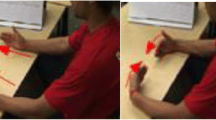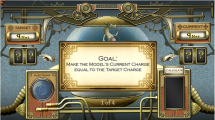Abstract
The Learning Physics through Play Project (LPP) engaged 6–8 year old students (n = 43) in a series of scientific investigations of Newtonian force and motion including a series of augmented reality activities. We outline the two design principles behind the LPP curriculum: 1) the use of socio-dramatic, embodied play in the form of participatory modeling to support inquiry; and 2) progressive symbolization within rich semiotic ecologies to help students construct meaning. We then present pre- and post-test results to show that young students were able to develop a conceptual understanding of force, net force, friction and two-dimensional motion after participating in the LPP curriculum. Finally, we present two case studies that illustrate the design principles in action. Taken together the cases show some of the strengths and challenges associated with using augmented reality, embodied play, and a student invented semiotic ecology for scientific inquiry.








Similar content being viewed by others
Notes
We have adapted the term ‘ambitious math instruction’ from (Lampert et al. 2010) which was used to refer to instruction that simultaneously targets conceptual understanding, procedural fluency and productive dispositions towards the domain.
Note that in previous presentations, this project was referred to as the Semiotic Pivots and Activity Spaces for Elementary Science (SPASES) Project NSF Award # DRL-0733218.
All names are pseudonyms.
The initial implementation of LPP allowed for all artwork to be substituted except for the ball. Students were, however, able to imagine the ball as a letter and referred to it as such throughout this activity. To avoid this challenge, however, future iterations will support a replacement of all visual elements in the system.
Large and medium are labels that the students chose to apply to those different forces.
They were asked to poke the soccer ball with a stick, rather than kick it, to better simulate an impulse force and to provide better control over the direction of the force.
References
Acredolo, C., Adams, A., & Schmid, J. (1984). On the understanding of the relationships between speed, duration, and distance. Child Development, 55, 2151–2159.
Bateson, G. (1976). A theory of play and fantasy. In J.S. Bruner, A. Jolly and K. Sylva (Eds.), Play—its role in development and evolution (pp 119–129). New York: Basic Books.
Bransford, J. (Ed.). (2000). How people learn: Brain, mind, experience, and school: National Academies Press.
Bullock, M., Gelman, R., & Baillargeon, R. (1982). The development of causal reasoning. In W. J. Friedman (Ed.), The developmental psychology of time. New York: Academic.
Clark, D. B., D'Angelo, C. M., & Schleigh, S. P. (2011). Comparison of students' knowledge structure coherence and understanding of force in the Philippines, Turkey, China, Mexico, and the United States. The Journal of the Learning Sciences, 20(2), 207–261.
Cobb, P. (2002). Reasoning with Tools and Inscriptions. The Journal of the Learning Sciences, 11, 187–215.
Cobb, P., Stephan, M., McClain, K., & Gravemeijer, K. (2001). Participating in Classroom Mathematical Practices. The Journal of the Learning Sciences, 10, 113–163.
Colella, V. (2000). Participatory simulations: Building collaborative understanding through immersive dynamic modeling. The Journal of the Learning Sciences, 9(4), 471–500.
Cooper, P. (2009). The classrooms all young children need: Lessons in teaching from Vivian Paley. Chicago: The University of Chicago Press.
Danish, J. A. (2009). BeeSign: A Design Experiment to Teach Kindergarten and First Grade Students About Honeybees From a Complex Systems Perspective. San Diego, CA: Paper presented at the annual meeting of the American Educational Research Association.
diSessa, A. A. (1988). Knowledge in pieces. In G. Forman & P. Putfall (Eds.), Constructivism in the computer age (pp. 49–70). Hillsdale, NJ: Lawrence Erlbaum Associates.
diSessa, A. A. (1993). Toward an Epistemology of Physics. Cognition and Instruction, 10(2), 105–225.
diSessa, A. A. (2000). Changing minds: Computers, learning, and literacy. Cambridge, Mass.: MIT Press.
diSessa, A. A., Hammer, D., Sherin, B., & Kolpakowski, T. (1991). Inventing Graphing: Meta-Representationsal Expertise in Children. The Journal of Mathematical Behavior, 10, 117–160.
Enyedy, N. (2005). Inventing Mapping: Creating cultural forms to solve collective problems. Cognition and Instruction, 23(4), 427–466.
Fauconnier, G., & Turner, M. (1998). Conceptual integration networks. Cognitive Science, 22(2), 133–187.
Goodwin, C. (2000). Action and embodiment within situated human interaction. Journal of Pragmatics, 32(1489–1522).
Greeno, J. G., & Hall, R. P. (1997). Practicing representation. Phi Delta Kappan, 78(5), 361–367.
Griffin, P., & Cole, M. (1984). Current activity for the future: The Zo-ped. New Directions for Child Development, 23, 45–64.
Hall, R., Stevens, R., & Torralba, A. (2002). Disrupting representational infrastructure in conversations across disciplines. Mind, Culture, and Activity, 9(3), 179–210.
Hestenes, D., Wells, M., & Swackhamer, G. (1992). Force concept inventory. The Physics Teacher, 30, 141–148.
Kato, H. (2006). The youthful energy for integration of engineering and arts: An augmented reality toolkit and its applications for ART. Joho Shori (45), 362–367.
Klahr, D. (2000). Exploring science: The cognition and development of discovery processes. Cambridge, MA: MIT Press.
Klopfer, E. (2008). Augmented learning: Research and design of mobile educational games. Cambridge, MA: MIT Press.
Lampert, M., Beasley, H., Ghousseini, H., Kazemi, E., & Franke, M. (2010). Using designed instructional activities to enable novices to manage ambitious mathematics teaching. Instructional Explanations in the Disciplines, 129–141.
Lehrer, R., & Schauble, L. (1998). Reasoning about structure and function: Children’s conceptions of gears. Journal of Research in Science Teaching, 31(1), 3–25.
Lehrer, R., & Schauble, L. (2000). Inventing data structures for representational purposes: Elementary grade students’ classification models. Mathematical Thinking and Learning, 2, 49–72.
Lehrer, R., & Schauble, L. (2006). Scientific thinking and science literacy. In R. W. Damon, K. Lerner, A. Renninger, & I. E. Sigel (Eds.), Handbook of child psychology (6th ed., Vol. 4). Hoboken, NJ: Wiley.
Lehrer, R., & Schauble, L. (2002). Symbolic communication in mathematics and science: Co-constituting inscription and thought. In E. D. Amsel & J. Byrnes (Eds.), Language, literacy, and cognitive development: The development and consequences of symbolic communication (pp. 167–192). Mahwah, NJ: Lawrence Erlbaum Associates.
Lehrer, R., Schauble, L., Carpenter, S., & Penner, D. E. (2000). The inter-related development of inscriptions and conceptual understanding. In P. Cobb, E. Yackel, & K. McClain (Eds.), Symbolizing and communicating in mathematics classrooms: Perspectives on discourse, tools, and instructional design (pp. 325–360). Mahwah, NJ: Lawrence Erlbaum Associates.
Matsuda, F. (2001). Development of concepts of interrelationships among duration, distance, and speed. International Journal of Behavioral Development, 25, 466–480.
Metz, K. E. (1995). Reassessment of Developmental Constraints on Children’s Science Instruction. Review of Educational Research, 65(2), 93–127.
Metz, K. E. (1997). On the Complex Relation Between Cognitive Developmental Research and Children’s Science Curricula. Review of Educational Research, 67(1), 151–163.
McGraw, K. O., & Wong, S. P. (1996). Forming inferences about some intraclass correlation coefficients. Psychological Methods, 1, 30–46.
Minstrell, J., & Stimpson, V. (1995). A classroom environment for learning: Guiding students’ reconstruction of understanding and reasoning. In R. Glaser & L. Schauble (Eds.), The contributions of instructional innovation to understanding learning. Boulder, CO: Paper presented at the Conference on Curriculum and Assessment Reform in Education.
Nemirovsky, R. (2003). Three Conjectures concerning the Relationship between Body Activity and Understanding Mathematics. Paper presented at the PME 27, Honolulu, Hawai-I.
Nemirovsky, R., Tierney, C., & Wright, T. (1998). Body Motion and Graphing. Cognition and Instruction, 16(2), 119–172.
Nicolopoulou, A. (1993). Play, cognitive development, and the social world: Piaget, Vygotsky, and beyond. Human Development, 36(1), 1–23.
Noble, T., Nemirovsky, R., Wright, T., & Tierney, C. (2001). Experiencing change: The mathematics of change in multiple environments. Journal for Research in Mathematics Education, 32(1), 85–108.
NRC. (2007). Taking Science to School: Learning and Teaching Science in Grades K-8. Washington, DC: National Academies Press.
Ochs, E., Gonzales, P., & Jacoby, S. (1996). “When I come down, I’m in a domain state”: Grammar and Graphic Representation in the Interpretive Activity of Physicists. In E. Ochs, E. A. Schegloff, & S. Thompson (Eds.), Interaction and Grammar (pp. 328–369). Cambridge: Cambridge University Press.
Piaget, J. (1952). Play, dreams and imitation in childhood. New York, NY, US: W. W. Norton & Co, Inc.
Roschelle, J. (1992). Learning by collaborating: Convergent conceptual change. The Journal of the Learning Sciences, 2(3), 235–276.
Roseberry, A. S., Warren, B., Ballenger, C., & Ogonowski, M. (2005). The generative potential of students’ everyday knowledge in learning science. In T. Romberg, T. Carpenter, & F. Dremock (Eds.), Understanding mathematics and everyday knowledge in learning science (pp. 55–80). Mahwah, NJ: Erlbaum.
Schauble, L. (1996). The development of scientific reasoning in knowledge-rich contexts. Developmental Psychology, 32(1), 102–119.
Sherin, B., diSessa, A. A., & Hammer, D. M. (1993). Dynaturtle revisited: Learning physics through collaborative design of a computer model. Interactive Learning Environments, 3(2), 91–118.
Siegler, R. S., & Liebert, R. M. (1975). Acquisition of formal experiment. Developmental Psychology, 11, 401–412.
Smith, J. P., diSessa, A. A., & Roschelle, J. (1994). Misconceptions reconceived: A constructivist analysis of knowledge in transition. The Journal of the Learning Sciences, 3(2), 115–163.
Suthers, D. D., & Medina, R. (2010). The temporal development of representational practices: Implications for theory and analysis of situated learning. Proceedings of the Hawaii International Conference on the System Sciences (HICSS-43), January 5- 8, 2010, Kauai, Hawaii (CD-ROM). New Brunswick: Institute of Electrical and Electronics Engineers, Inc. (IEEE).
Vygotsky, L. S. (1978). Mind in society: The development of higher psychological processes. Cambridge: Harvard University Press.
White, B. (1993a). Intermediate Causal Models: A missing link for successful science education? In R. Glaser (Ed.), Advances in Instructional Psychology (Vol. 4, pp. 177–252). Hillsdale, NJ: Lawrence Erlbaum Assoc.
White, B. (1993b). Thinker tools: Causal models, conceptual change, and science education. Cognition and Instruction, 10(1), 1–100.
Yoachim, C. M., & Meltzoff, A. N. (2003). Cause and effect in the mind of the preschool child. Park City: Paper presented at the biennial meeting of the Cognitive Development Society.
Yoon, S., Steinmeier, C., Wang, J., & Tucker, S. (2011). Learning science through knowledge-building and augmented reality in museums. In G. S. Hans Spada, N. Miyake, N. Law (Ed.), Connecting Computer- Supported Collaborative Learning to Policy and Practice: CSCL2011 Conference Proceedings. Volume I — Long Papers (pp. 9–16). HongKong, China: International Society of the Learning Sciences.
Youngquist, J., & Pataray-Ching, J. (2004). Revisiting “Play”: Analyzing and Articulating Acts of Inquiry. Early Childhood Education Journal, 31, 171–178.
Acknowledgements
This project was supported by a grant from the National Science Foundation (DRL-0733218). This project would also not be possible without the help from members of our team who are not authors on this paper Fabian Wagmister, Jeff Burke and Alessandro Marianantoni. Finally we would like to thank Sylvia Gentile who taught the lessons and led the students in some remarkable discussions of force and motion.
Author information
Authors and Affiliations
Corresponding author
Rights and permissions
About this article
Cite this article
Enyedy, N., Danish, J.A., Delacruz, G. et al. Learning physics through play in an augmented reality environment. Computer Supported Learning 7, 347–378 (2012). https://doi.org/10.1007/s11412-012-9150-3
Received:
Accepted:
Published:
Issue Date:
DOI: https://doi.org/10.1007/s11412-012-9150-3




